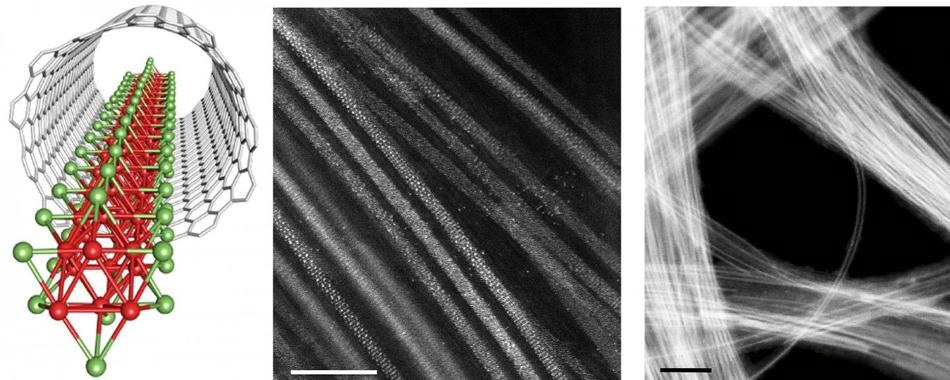Apr 22 2019
At Tokyo Metropolitan University, scientists have successfully created nanowires of transition metal monochalcogenide (TMM) using carbon nanotube templates.
 This is a schematic and electron microscopy images of single wires of molybdenum telluride formed inside carbon nanotubes. These 1D reaction vessels are a good fit for the wires, and confine the chemical reactions which create them to one direction. Epitaxial (layer by layer) growth can then proceed along the inner walls of the tubes. (Image credit: Tokyo Metropolitan University)
This is a schematic and electron microscopy images of single wires of molybdenum telluride formed inside carbon nanotubes. These 1D reaction vessels are a good fit for the wires, and confine the chemical reactions which create them to one direction. Epitaxial (layer by layer) growth can then proceed along the inner walls of the tubes. (Image credit: Tokyo Metropolitan University)
These nanowires measure just three atoms broad in diameter and are 50 times longer when compared to earlier attempts. In addition, they can be examined in isolation, retaining the characteristics of atomically quasi “1D” objects.
The researchers noted that when individual wires are disturbed, they have a tendency to twist. This indicates that isolated nanowires possess special mechanical characteristics, which can possibly be used for switching in nanoelectronics.
In the span of less than 20 years, 2D materials have shifted from hypothetical curiosity to real-life application. Graphene is the most popular example of 2D materials, consisting of well-organized sheets of carbon atoms. Although the complete potential of graphene is yet to be exploited, its extraordinary thermal and electrical conductivity, mechanical resilience, and optical characteristics have already resulted in an array of industrial applications. A few instances include bio-sensing, energy storage solutions, and even substrates meant for artificial tissue.
However, in spite of the effective transition from 3D to 2D, it has been rather difficult to overcome the obstacle separating 2D and 1D. Now, a group of materials called transition metal monochalcogenides (TMMs, transition metal + group 16 element) have attracted a great deal of attention as a promising nanowire in precision nanoelectronics. For more than three decades, hypothetical studies have existed and besides that, preliminary experimental researches have succeeded in creating small amounts of nanowires. However, these were extremely short, often bundled, combined with bulk material or merely low yield, especially when precision methods were involved, for example, lithography. In particular, the bundling was more challenging; forces called van der Waals forces would make the wires to combine together, successfully concealing all the exclusive characteristics of 1D wires that one may wish to access and utilize.
Currently, a group of researchers, headed by Assistant Professor Yusuke Nakanishi from Tokyo Metropolitan University has successfully created huge amounts of single nanowires of TMM that were well isolated. Using small, open-ended rolls of one-layered carbon, or carbon nanotubes (CNTs), the researchers began to template the arrangement and reaction of tellurium and molybdenum into wires from a vapor. Eventually, they effectively created single isolated wires of TMM, which had a thickness of just 3 atoms and measured 50 times longer compared to those developed using current techniques. It was also demonstrated that these nanometer-sized CNT “test tubes” were not chemically adhered to the wires, efficiently retaining the characteristics anticipated from isolated TMM nanowires. Most significantly, the CNT test tubes effectively “protected” the wires from one another, enabling unparalleled access to how these 1D objects act in isolation.
When the researchers used transmission electron microscopy (TEM) to image these objects, they discovered that these wires displayed an unusual twisting effect upon exposure to an electron beam. That behavior was never observed before and is believed to be special to isolated wires. The shift from a straight structure to a twisted one could provide a new switching mechanism when the material is integrated into very tiny circuits. The researchers hope that the potential to create well-isolated 1D nanowires may considerably provide a deeper insight into the mechanisms and properties behind the function of 1D materials.
The study was partly supported by a KAKENHI Grant-in-Aid for Young Scientists (18K14088).